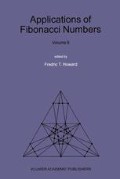Abstract
Cohn (see [1]) determined all the Fibonacci and the Lucas numbers which are squares and London & Finkelstein (see [3]) found all the Fibonacci and the Lucas numbers which are cubes. Luo Ming (see [4], [5], [6], [7]) has determined all the Fibonacci and the Lucas numbers which are either triangular or pentagonal and Williams (see [9]) found all the Fibonacci numbers which are of the form k 2 +1 for some integer k. Stark (see [2]), or [8]) asks which Fibonacci numbers are half the difference (or sum) of two cubes.
This work was partially supported by the Alexander von Humboldt Foundation.
Access this chapter
Tax calculation will be finalised at checkout
Purchases are for personal use only
Preview
Unable to display preview. Download preview PDF.
References
Cohn, J.H.E. “On square Fibonacci numbers.” J. London Math. Soc., Vol. 39 (1964): pp. 537–540.
Guy, R.K. Unsolved Problems in Number Theory. Springer-Verlag, New York, (1981): p. 106.
London, H. and Finkelstein, R. “On Fibonacci and Lucas numbers which are perfect powers.” The Fibonacci Quarterly, Vol. 7 (1969): pp. 476–481, 487. (Errata The Fibonacci Quarterly, Vol. 8 (1970): p. 248).
Ming, L. “On triangular Fibonacci numbers.” The Fibonacci Quarterly, Vol. 27 (1989): pp. 98–108.
Ming, L. “On triangular Lucas numbers.” Applications of Fibonacci Numbers, Volume 4. Edited by G.E. Bergum, A.F. Horadam and A.N. Philippou. Kluwer Academic Publishers, Dordrecht, The Netherlands, 1991: pp. 98–108.
Ming, L. “Pentagonal numbers in the Fibonacci sequence.” Applications of Fibonacci Numbers. Volume 6. Edited by G.E. Bergum, A.F. Horadam and A.N. Philippou. Kluwer Academic Publishers, Dordrecht, The Netherlands, 1994: pp. 349–354.
Ming, L. “Pentagonal numbers in the Lucas sequence.” Portugaliae Mat., Vol. 53 (1996): pp. 325–329.
Stark, H.M. Problem 23, Summer Institute on Number Theory, Stony Brook, 1969.
Williams, H.C. “On Fibonacci numbers of the form k 2 + 1.” The Fibonacci Quarterly, Vol. 13 (1975): pp. 213–214.
Editor information
Editors and Affiliations
Rights and permissions
Copyright information
© 1999 Springer Science+Business Media Dordrecht
About this chapter
Cite this chapter
Luca, F. (1999). Fibonacci Numbers of the Form k2+k+2. In: Howard, F.T. (eds) Applications of Fibonacci Numbers. Springer, Dordrecht. https://doi.org/10.1007/978-94-011-4271-7_24
Download citation
DOI: https://doi.org/10.1007/978-94-011-4271-7_24
Publisher Name: Springer, Dordrecht
Print ISBN: 978-94-010-5851-3
Online ISBN: 978-94-011-4271-7
eBook Packages: Springer Book Archive

